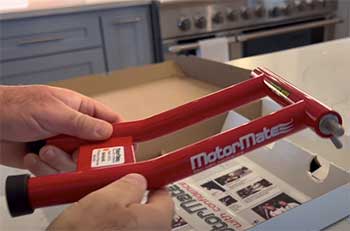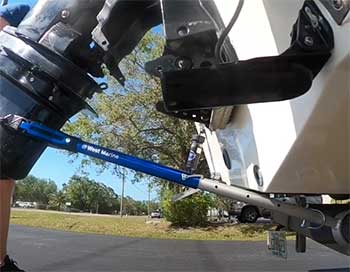If you’re a boat owner, you’ve likely come across products like MotorMate and Transom Saver. But what exactly are they, and how are they different?
In this comprehensive guide, we’ll explore the key differences between MotorMate and Transom Saver, their features and benefits, and help you determine which is better for your boat.
A Brief Comparison Table
| Feature | MotorMate | Transom Saver |
| Design | Contoured stainless steel bar | Straight aluminum crossbar |
| Mounting | Padded brackets bolted to transom | Holes drilled in transom |
| Speed Capability | Engine support at all speeds | Stationary use only |
| Tilting Allowance | Unimpeded range of motion | Fixed positions with tilt limitations |
| Weight Capacity | 300HP standard, 800HP max | Around 150HP max |
| Main Benefit | Absorbs vibration and impact while underway | Supports tilted motor when stationary |
| Best Suited For | 150HP+, offshore boats, high usage | Portable motors <150HP, limited hours |
| Installation | Brackets bolted to transom | Holes drilled in transom |
Overview of MotorMate and Transom Saver
First, let’s briefly overview what MotorMate and Transom Saver are:

MotorMate – A device that attaches to the transom of a boat to provide additional support for the outboard motor when underway.
It helps absorb engine vibration and allows the motor to tilt/trim normally.
Transom Saver – A bar that spans the transom of a boat when the outboard motor is tilted up.
It transfers the motor’s weight from the transom to the boat’s stringers to prevent transom damage.
So in essence, MotorMate focuses on motor support while running, and Transom Saver focuses on supporting the tilted motor while stationary. But there are more detailed differences we’ll now explore.
Key Differences Between MotorMate And Transom Saver
Design and Mounting
The first major difference between MotorMate and Transom Saver is their design and how they mount to the transom.
- MotorMate utilizes a curved stainless steel bar that contours to the boat’s transom. It has padded brackets that bolt directly to the transom without drilling holes. This keeps the mount hidden and preserves the transom when removed.
- Transom Saver uses a straight aluminum crossbar that runs the width of the transom. Installation requires drilling holes in the transom to bolt the mount in place. This leaves permanent holes that must be sealed when removed.
Boat Speed Support
Since MotorMate stays on while running, it must withstand boat speeds and engine forces. Transom Saver only sees forces while stationary.
- MotorMate is engineered to handle the rigorous loads exerted at high speeds. Its padded brackets absorb vibration and impact. At rest, it carries the motor’s static weight.
- Transom Saver is only designed to carry the motor’s weight while stationary. It should be removed before going above idle speeds, as it cannot handle run forces without failing.
Tilting Capability

A major function of both products is allowing normal trim and tilt of the outboard.
But they achieve this in different ways.
- The MotorMate freely pivots with the motor as it trims and tilts. Its curved arm has clearance slots that provide an unimpeded range of motion.
- Transom Saver has fixed positions and requires removing pins to tilt the motor past a certain point. This also means tilting ability is limited by the crossbar design.
Weight Bearing Capacity
MotorMate and Transom Saver support different maximum outboard motor weights.
- MotorMate is rated to handle motors up to 300 HP with no modification. Heavier configurations are available to support up to 800 HP.
- Transom Saver typically supports a maximum of around 150 HP. Excessive weight can cause it to crack or break, requiring reinforcement modifications.
MotorMate Benefits and Features
Now that we’ve directly compared MotorMate and Transom Saver, let’s detail the unique benefits and features of the MotorMate system:
- Absorbs engine vibration and impact while underway
- Allows full, unimpeded trim and tilt functionality
- Supports motors up to 300 HP standard, 800 HP max
- Contoured stainless steel bar resists corrosion
- Padded mounting brackets prevent transom damage
- Easy 15-minute installation without drilling holes
- Higher resale value from transom condition preservation
- Protects outboard power tilt rams from damage
- Significantly reduces transom stress and fatigue
- Quick lateral motor adjustment with sliding brackets
- No need to detach before getting underway
- Designed and manufactured in the USA
The MotorMate really shines when you’re running offshore and encounter rough water. The loads exerted on the transom in waves can be enormous, quickly accelerating wear. By supporting the weight and absorbing vibration, MotorMate preserves the transom and extends its life. It also protects critical components like the power tilt rams from damage due to impact.
Many owners report the MotorMate significantly reduces overall transom movement. This provides a more solid feel underway and leads to decreased driver fatigue. It also keeps the prop submerged and thrust oriented properly in choppy conditions.
For bass boats and other performance craft, the MotorMate maintains efficient hull attitude by preventing the motor from creeping up. This optimizes speed and fuel efficiency.
The quick lateral adjustability is also beneficial for fine tuning drive height and dialing in the optimal running angle.
Also Read: Comparison of Bass Tracker Classic XL And Pro 170 Boats.
Transom Saver Benefits and Features
Transom Savers also have a number of advantages:
- Prevents transom damage while motor is tilted
- Directly transfers weight to stringers and foundation
- Allows motor to be tilted clear of water while stationary
- Significantly cheaper than MotorMate systems
- Easy installation without complex brackets
- Compact storage when removed before transport
The main benefit of the Transom Saver is protecting the tilted motor from damage if it unexpectedly drops into the full down position. By supporting the weight on the stringers, it also prevents stress cracks and damage to the transom gelcoat.
For budget-minded boaters or those with smaller motors under 150 HP, a Transom Saver can provide adequate stationary tilt support. Just be sure to remove it before operating above idle speeds.
Which Is Better For Your Boat?
Determining whether MotorMate or Transom Saver is the better choice depends on several factors:

- Your motor’s horsepower rating
- Desired maximum speed capability
- Offshore usage and sea conditions
- Transom material (wood vs. composite)
- Concerns about resale value
For most owners, the MotorMate’s ability to withstand high speeds and offshore conditions makes it better suited for larger motors and more heavy usage.
It offers a great return on investment by protecting the transom and engine.
Transom Savers work well for portable motors under 150HP that are tilted clear of the water when stationary.
Just don’t make the mistake of leaving them on at higher speeds.
Here is a quick guideline:
- MotorMate – Recommended for motors 150HP and up, offshore boats, and high hours of annual usage.
- Transom Saver – Ideal for portable motors under 150HP with limited hours and protected docking.
Installing Your Transom Support
Briefly, let’s cover proper installation best practices:
- MotorMate – Follow the instructions to find optimal lateral and vertical positioning. Make sure to use lock washers on all mounting bolts. Check that no wiring is pinched between the transom and brackets.
- Transom Saver – Position the ends 4-6 inches away from the motor bracket. Use lock washers on all bolts and seal holes with silicone when removing. Check clearance and remove any pins needed for full tilt.
Be sure to inspect your transom support periodically for any wear or corrosion. Catching problems early prevents more significant damage down the road.
Also Read: Comparison of Dock Blocks And Jet Dock.
Frequently Asked Questions (FAQ)
Here are answers to some common questions about MotorMate and Transom Savers:
While both provide transom support, the MotorMate differs in being engineered for high speeds and offshore use. So technically it isn’t considered in the same class as a basic transom saver.
A transom saver only bears weight while the motor is tilted. A motor support like the MotorMate supports the motor in all positions – tilted, trimmed, and underway.
For smaller motors, a transom saver provides inexpensive protection while docked. It prevents tilt bracket damage if the motor drops. For larger offshore motors, the MotorMate is a better running support.
For any motor over 150 HP, a product like the MotorMate provides important support underway. This reduces stress on the transom and engine components. The benefits are most noticeable offshore and in rough water conditions.
Final Thoughts
While MotorMate and Transom Saver share similarities, they have distinct differences in their engineering and capabilities. Understanding these allows selecting the best transom support for your usage.
For high horsepower motors and offshore boats, MotorMate is unrivaled for preserving transoms and extending engine life. But for light duty tilt support on smaller motors, a transom saver may suffice when used properly. Follow the guide above to choose the right match for your boat.
With your transom and engine properly supported, you can have peace of mind on the water for many seasons of boating ahead.

